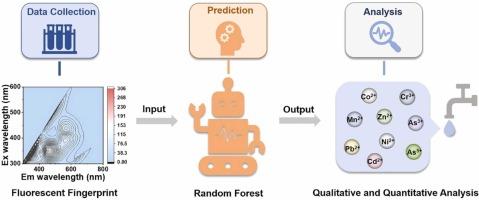机器学习辅助重金属多传感三维荧光
IF 3.7
1区 化学
Q1 CHEMISTRY, ANALYTICAL
引用次数: 0
摘要
重金属污染是普遍、复杂和多样的,对人类健康造成持久和潜在的毒性影响。因此,有必要发展高通量重金属检测技术。在这项工作中,我们提出了一种基于机器学习的三维荧光传感器策略,用于有效检测重金属污染。具体而言,首先用两种不同颜色的cd和5,10,15,20-四(4-三甲氨基)苯基卟啉(TAPP)构建了多发射荧光“化学鼻/舌”传感器,用于识别9种重金属,然后根据各种重金属对三维荧光光谱的影响获得荧光指纹。结果表明,该传感器在10 μM-0.5 mM的浓度范围内,能方便、快速地识别出多种单一重金属离子和二元混合重金属离子的种类和浓度,并对数据输入方式进行了优化,结果表明,图像识别预测重金属离子种类和浓度的准确率分别为75.1%和64.4%,数据识别准确率分别为97.8%和100%。对学习模型进行优化后,随机森林(Random Forest, RF)模型预测二元重金属混合物的种类和浓度的准确率分别为100%和91.8%。此外,机器学习辅助荧光传感器在实际自来水和河流样本中显示出有前景的应用。综上所述,与以往的分析方法相比,该方法通过三维荧光光谱结合ML策略实现了复杂环境中重金属的定性和定量分析。值得注意的是,该传感器不涉及多个传感通道的繁琐合成,使其易于构建且具有成本效益。本文章由计算机程序翻译,如有差异,请以英文原文为准。

Machine learning-assisted three-dimensional fluorescence for heavy metal multi-sensing
Heavy metal pollution is pervasive, complex, and diverse, causing lasting and potentially toxic effects on human health. Therefore, it is necessary to develop high-throughput detection of heavy metals. In this work, we proposed a machine learning-based three-dimensional fluorescent sensor strategy for effective detection of heavy metal pollution. Specifically, a multi-emitting fluorescent "chemical nose/tongue" sensor was first constructed with two different colored CDs and 5,10,15,20-tetrakis(4-trimethylamino) phenyl porphyrin (TAPP) for discriminating nine heavy metals, and then the fluorescence fingerprints were obtained based on the changes in the three-dimensional fluorescence spectra influenced by various heavy metals. The results demonstrated that the sensor easily and rapidly discriminated the categories and concentrations of multiple single heavy metal ions and binary mixed heavy metal ions within the concentration range of 10 μM–0.5 mM. Subsequently, the data input way was optimized, and the results showed that the accuracy of image recognition in predicting categories and concentrations of heavy metal ions was 75.1 % and 64.4 %, and the accuracy of data recognition was 97.8 % and 100 %. After optimizing the learning model, the Random Forest (RF) model can predict the categories and concentrations of a binary heavy metal mixture with accuracies of 100 % and 91.8 %, respectively. In addition, machine learning-assisted fluorescent sensors showed promising applications in real tap water and river samples. In conclusion, compared to previous analysis methods, this approach achieved qualitative and quantitative analysis of heavy metals in complex environments through three-dimensional fluorescence spectra combined with the ML strategy. Notably, the sensor did not involve cumbersome synthesis of multiple sensing channels, making it easy to construct and cost-effective.
求助全文
通过发布文献求助,成功后即可免费获取论文全文。
去求助
来源期刊

Sensors and Actuators B: Chemical
工程技术-电化学
CiteScore
14.60
自引率
11.90%
发文量
1776
审稿时长
3.2 months
期刊介绍:
Sensors & Actuators, B: Chemical is an international journal focused on the research and development of chemical transducers. It covers chemical sensors and biosensors, chemical actuators, and analytical microsystems. The journal is interdisciplinary, aiming to publish original works showcasing substantial advancements beyond the current state of the art in these fields, with practical applicability to solving meaningful analytical problems. Review articles are accepted by invitation from an Editor of the journal.
 求助内容:
求助内容: 应助结果提醒方式:
应助结果提醒方式:


